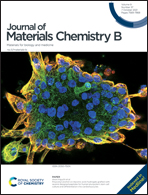Ion release behavior of vanadium-doped mesoporous bioactive glass particles and the effect of the released ions on osteogenic differentiation of BMSCs via the FAK/MAPK signaling pathway†
Abstract
Vanadium is an important trace element in bone and is involved in bone metabolism, bone formation, and bone growth, but the roles of various vanadium ions, especially of pentavalent vanadium, in bone tissue regenerative repair have been underestimated and even misinterpreted for a long time. The main purposes of this study are to investigate the release profile of Si, Ca, P, and V ions from vanadium doped mesoporous bioactive glass (V-MBG) particles and to explore the effect of pentavalent vanadium ions on proliferation and osteogenic differentiation of BMSCs as well as the corresponding osteogenic signaling pathway. On the basis of preparations of V-MBG particles with different pentavalent vanadium contents, the ion release behavior from V-MBG in distilled water and simulated body fluid was systemically investigated. Furthermore, the cytocompatibility and osteogenic effect of V-MBG extracts were studied in rBMSCs, and the related molecular mechanisms were preliminarily discussed. The results of dissolution experiments showed that the V ionic concentration exhibited a burst increase and then a sustained slow increase in the two media. The resultant V ions from 1.0V-MBG, 4.0V-MBG and 10.0V-MBG at 21 days were about 1.1, 5.8, and 12.5 mg L−1 in water, respectively, and 1.6, 4.8 and 12.8 mg L−1 in SBF, respectively. The release behaviors of Si, Ca, P, and V ions were evidently affected by high contents of incorporated vanadium. The cellular results indicated that compared to the control and MBG groups, the V(V) ions in V-MBG extracts at about 19.4 μM markedly promoted the proliferation, the gene and protein expression of BMP-2 and COL-I, and the ALP activity of rBMSCs in non-osteoinductive media, but insignificantly stimulated the OCN protein synthesis. More deeply, V(V) ions at about 19.4 μM significantly upregulated the gene and protein expressions of Itga 2b, FAK, and pERK1/2, demonstrating that V(V) ions could regulate osteogenic differentiation of rBMSCs through the activation of the Itga 2b–FAK–MAPK (pERK1/2) signaling pathway. The in vivo results further confirmed that V-MBG induced and promoted new bone formation in the defect area compared to the PGC and PGC/V-M0 groups. These results would contribute to modify the perception about the biocompatibility and osteogenic promotion of pentavalent vanadium at an appropriate concentration.



 Please wait while we load your content...
Please wait while we load your content...